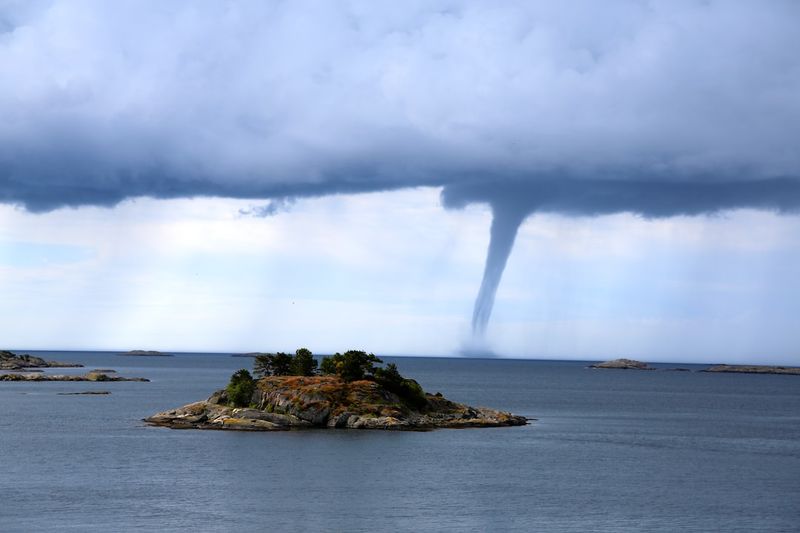Deadly Tornadoes Sweep Across the Great Lakes, Leaving Destruction in Their Wake
Overview
On August 24, 2023, a series of severe storms and tornadoes struck the Great Lakes region, causing significant damage and claiming the lives of five individuals. The states of Michigan and Ohio were particularly affected, with Michigan experiencing at least three tornadoes, one of which swept across Interstate 96 near Lansing, causing the death of a driver and damaging 25 vehicles. In Ohio, a tornado caused extensive damage to Calvary Church and other structures in Cleveland. Additionally, heavy rains led to flooding in Detroit, resulting in significant travel disruptions and damage to the city’s infrastructure.
Rating the Tornadoes
The National Weather Service (NWS) utilized the Enhanced Fujita (EF) scale to rate the intensity of the tornadoes. The tornado near Lansing, Michigan, was classified as an EF-2 tornado, indicating significant damage potential, while the tornado in Kent County near Grand Rapids was preliminarily rated as an EF-1 tornado, denoting moderate damage potential. The NWS also confirmed a third tornado in Cleveland, Ohio, which caused extensive damage.
Impacts on Michigan
In Ingham County, Michigan, one individual lost their life, and numerous cars were severely damaged when a tornado struck along Interstate 96. The scene was described as chaotic, with more than 25 vehicles affected and several people suffering serious injuries. The interstate remained closed into Friday due to downed trees and power lines.
Impacts on Ohio
In Cleveland, Ohio, the EF-1 tornado caused damage to Calvary Church and bent light poles at a shopping center. This tornado lasted for approximately three minutes and left a trail of destruction as it moved through the city.
Flooding in Detroit
The heavy rains that accompanied the severe storms resulted in flooding in Detroit, causing significant disruptions to transportation and infrastructure. Parts of Interstates 94, 75, and 275 were closed due to flooded roads, and the Detroit airport experienced flooding for the second consecutive day. Detroit received a total of 3.50 inches of rain during this weather event, ranking it as the 5th-wettest day in the history of Detroit Airport.
Analysis and Discussion
The Impact of Natural Disasters
Natural disasters, such as tornadoes and floods, can have profound impacts on individuals, communities, and the overall infrastructure of affected areas. The Great Lakes region is no stranger to severe weather events, but the recent tornado outbreak serves as a stark reminder of the destructive power of nature. Lives were lost, properties damaged, and transportation disrupted, leaving a lasting impact on the affected regions.
Climate Change and Extreme Weather
The occurrence of more frequent and intense weather events like tornadoes can be attributed, at least in part, to climate change. As global temperatures rise, the atmosphere becomes more unstable, creating favorable conditions for severe storms and tornadoes to form. This raises important questions about our preparedness for the increasing frequency and intensity of extreme weather events. Adequate infrastructure, emergency response systems, and climate change mitigation measures become crucial in protecting vulnerable communities.
Preparing for Future Events
In the face of such destructive weather events, it is critical to strengthen our preparedness and response capabilities. This includes ensuring that warning systems are in place and effectively communicated to the public, developing robust emergency response plans, and investing in resilient infrastructure. Individuals should also take personal responsibility for their safety and be proactive in preparing for potential natural disasters, such as having emergency kits and evacuation plans.
Editorial and Advice
Investing in Resilience
The recent tornado outbreak in the Great Lakes region calls for a renewed focus on investing in resilience. This includes both short-term measures to address immediate needs, such as emergency response and recovery efforts, as well as long-term strategies to mitigate the impacts of future natural disasters. Governments at all levels must allocate resources to improve infrastructure, strengthen building codes, and enhance early warning systems.
Climate Change Mitigation
Addressing the root causes of the increasing frequency and severity of extreme weather events requires concerted efforts to mitigate climate change. This involves transitioning to cleaner and renewable sources of energy, reducing greenhouse gas emissions, and implementing sustainable land-use practices. By taking action on climate change, we can help prevent future generations from experiencing the devastating consequences of natural disasters.
Community Resilience
Building resilience at the community level is also crucial. It is essential for individuals, neighborhoods, and local organizations to come together and support each other during times of crisis. By fostering a sense of community, sharing resources, and developing local emergency response networks, communities can better withstand and recover from natural disasters. It is equally important for individuals to take personal responsibility for their safety by staying informed, creating emergency plans, and being prepared.
Conclusion
The recent tornado outbreak in the Great Lakes region serves as a somber reminder of the destructive power of nature. As we face the increasing frequency and intensity of extreme weather events, it is imperative that we prioritize resilience, climate change mitigation, and community preparation. By working together and taking proactive measures, we can minimize the impacts of natural disasters, protect lives, and build a more resilient future.

<< photo by Nati Melnychuk >>
The image is for illustrative purposes only and does not depict the actual situation.
You might want to read !
- Deadly Devastation: Unraveling the Tragedy of Michigan’s Severe Storms
- Carlos Santana’s Troubling Remarks: Examining the Impact of Anti-Trans Rhetoric at a New Jersey Concert
- The Controversial Departure: Exploring Melissa Joan Hart’s Firing from ‘Sabrina’ After Maxim Cover
- “Surprising Respite: SE Michigan Spared from Severe Weather Havoc”
- A Tale of Two Teams: Mastodon WSOC’s Journey through the Midwest
- Texas Battling Tropical Storm Harold: Flash Floods Imperil Landfall
- West Coast Shaken: Analyzing the Implications of the 5.1 Magnitude Ojai Earthquake
- Earthquake Shake-Up: Analyzing the Impact of the Magnitude-5.1 Earthquake in Ventura County
- Bracing for Dual Disasters: California Quake and Approaching Hurricane Hilary
- Tornado Warnings Canceled: Analyzing the Impact of Severe Weather on Metropolitan Areas
- “Severe Weather Forces Early Departure for Federal Workers in DC”
- Powerless in the Storm: Assessing the Impact of Severe Weather on the East Coast
- Extreme Weather Havoc: Power Outages Impact 1 Million Customers in 11 States
- Power Outages Sweep through Towns: Thousands Left in the Dark as Severe Storms Wreak Havoc




